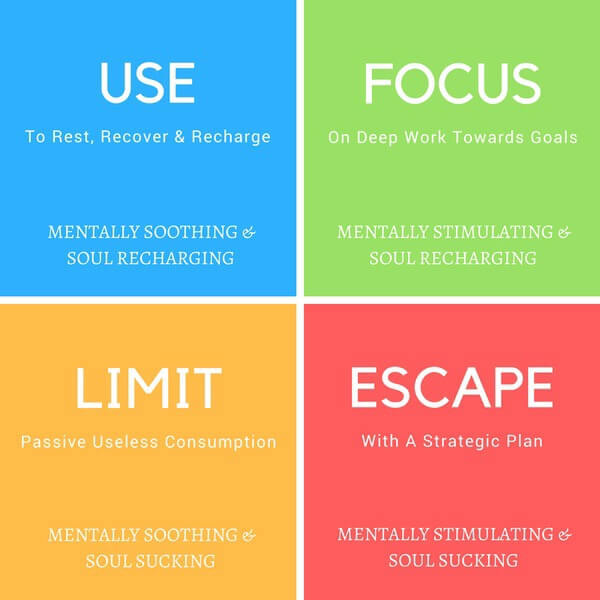You know that feeling when sometimes you’re all fired up and focused to work. While sometimes, you’re too tired to even do simple math.
Like physical energy, your mind also has a capacity. You can only create, consume or learn so much in a day.
Before I didn’t understand my energy, I would depend on my energy to dictate my actions. While such an approach helped me to stay sane, it was not the best way to optimize my work and life.
If you ask a creative person, they will tell that they don’t rely on their motivation to create. Most of them have a routine and they get the job done even when they don’t feel like it.
Showing up is half the battle won. But to win the other half of the battle, you must manage your energy.
Before I explain how you can understand and manage your energy, let’s have a quick look at the concept of time management from the famous — Eisenhower Matrix.
The simple rules to effectively manage your time are:
- Manage short-term crisis and problems (Important and urgent work)
- Focus on long-term strategic goals (Important but not urgent work)
- Avoid distractions and interruptions (Urgent but not important)
- Limit time-wasting activities (Not important and not urgent)

Time Management
This approach is great to manage your tasks, but it falls short as it does not consider how well you perform the tasks.
To understand your energy, you need to analyze yourself first.
One of the big five personality traits is the scale of extraversion.
If you fall more towards the introvert side of the spectrum, you’ll recharge by spending time alone. But if you’re more of an extrovert, you’ll recharge by being around people.
Find out activities that fuel you.
For extroverts, it could be having a meal with friends or family, doing small talks throughout the day, working in open workspace (but still having boundaries for no distractions while working), etc.
For introverts, activities could involve reading, painting, journaling, spending time in nature, working in an isolated environment, etc.
Being an introvert or extrovert is not all black and white. We have traits of each personality type. Many people fall closer to the middle of the scale which makes them a mix of both.
No matter what your personality is, don’t use it as an excuse to limit yourself. You can always develop skills of another personality type if you work on it.
Having said that, embrace your nature and find ways to recharge your unique self.
After doing the self-analysis, let’s learn how you can manage your energy for optimal performance.
Here are the 4 types of activities:
1. Mentally Soothing and Soul Recharging
Activities may vary according to your personality as discussed earlier. Regardless of your introverted or extroverted nature, picking up a hobby or doing enjoyable tasks which require less mental effort fall under this category.
2. Mentally Stimulating and Soul Recharging
Activities involve creating, learning, working on a passion project, problem-solving, etc. This is the space when you need to thrive and perform with high energy levels.
3. Mentally Soothing and Soul Sucking
It involves not being your authentic self, doing things to please others, over-consumption of negative news, useless drama or social media, etc. These activities may not seem to affect you in that moment, but they result in wasted time and energy. They may occupy your mind for a long time and make you unfocused when it’s time to perform.
4. Mentally Stimulating and Soul Sucking
This is the 9–5 job that you absolutely hate (not all jobs are like that but you know the ones I’m talking about). When you’re forced to work and solve problems with no purpose or aspiration, it not only depletes your mental resources, it also crushes your soul.
Another example of such a situation is being in relationships with wrong people. They may take you for granted and ask for favors but never show up when you need help. They can influence you negatively, bring you down and leave negative vibes when you’re around them.
The worse is when they pretend to be your friend but they don’t want the best for you. Beware of such people because they will not only suck the soul out of you, but they can mentally keep you busy with their never-ending needs and demands.

Energy Management
Perform Soul Recharging Activities
In an ideal world, your goal is to do the activities that recharge your soul. These activities could be common or they can be unique that work for you.
You can switch between mentally stimulating and mentally soothing activities to manage your mental energy.
If you’re stuck in a situation where you have to perform soul-sucking activities, then try your best to change your perception. Find meaning in the smallest things and take it as a challenge to overcome. It could become your story of struggle that you can embrace and share.
16 Energy Hacks That Will Give You A Boost On Demand
Some activities can charge you up so well that you can use them as a pre-performance or recovery ritual. Some energy hacks can fix dopamine, serotonin or oxytocin deficiency in a healthy way. They can boost your motivation, help you manage your mood, keep you focused and calm.
Here are few options you can try out and see which energy hacks work for you:
1. Listen to Music
To enhance your focus while doing deep work, you can listen to background sounds or music—Nature, cafe, classical music, video game music, etc.
When you want to feel pumped up, listen to music with high energy to boost your motivation.
You can also listen to music for leisure as a mentally soothing and soul recharging activity.
2. Sleep or Take a Nap
Sleep is the ultimate way to rejuvenate. Get 7–9 hours of sleep every day and notice the magical transformation in your energy, focus, and mood.
If you fall short on sleep, you can also take power naps in the afternoon to wake up refreshed and ready to tackle the rest of the day.
‘Coffee nap’ is a hack many high-performers use to boost their energy levels. In this method, you drink coffee right before taking a nap. By the time the caffeine kicks in, you will wake up super recharged in about 30 minutes.
Just make sure not to drink too much caffeine regularly. You want to avoid getting dependent on caffeine for energy. Also, avoid taking a nap or drinking coffee in the evening or at night so you can get quality sleep at night.
3. Deep Breathing or Meditation
Deep breathing signals your brain to relax. It supplies oxygen to the brain and helps us to regain focus.
Observing your thoughts is another way to hit the pause button and watch yourself from an outside perspective. Notice the thoughts entering your mind and then let them go one by one. The thoughts will come back or new thoughts will enter your brain but your job is to simply observe and let them go.
Another approach is to daydream or do nothing. Because we live in the age of the internet, we spend a lot of our time in front of a screen. Our brain hardly gets any chance to rest.
To improve your creativity, give your brain some time to wander. Give it some private space where there is no external stimulation from people, phone or computer.
4. Move
Physical movement has proven to improve memory, cognition function and beat depression. Choose how you want to exercise — Lift weights, do bodyweight exercises, run, swim, or play a sport.
For best results, move often, do resistance training (through weights or bodyweight) and do some cardiovascular exercises.
On the days when you don’t get the chance to workout, try to keep your body active by switching between standing and sitting while working. You may also do jumping jacks or walk a few steps between the sitting time.
Stretching, yoga, tai chi, qigong, and self-massaging by using a foam roller are good ways to loosen up the body and decompress the spine. Inversion (hanging upside down) or holding handstand position improves blood flow to the brain. You can use a wall to support yourself while doing a supported handstand. But only perform the move once you have enough strength to hold your own bodyweight.
5. Cold Showers
The benefits of cold showers are similar to physical exercise for cognition and energy. It energizes you, makes you more alert and improves your mood.
6. Eat Well and Hydrate
I can’t emphasize the power of nutrition enough. Eat nutrient-dense foods to get an adequate amount of vitamins, minerals, and phytochemicals.
Keep your body and brain healthy by drinking enough water, eating enough protein, colorful vegetables and fruits, healthy fats and other healthy foods that your body digests well.
The key is to listen to your body. Notice how it reacts to different foods and adjust accordingly.
Avoid simple carbs and sugars to not get blood glucose spike and crash. Keep your blood glucose stable by eating fiber-rich complex carbs which will maintain your energy levels.
7. Express Gratitude
Practice the skill of happiness by being grateful. Stop the negative chatter and switch to a beautiful state.
8. Do Random Acts of Kindness
Leaving a kind review or a comment, helping a stranger, answering a question on Quora, writing a thank you letter are some ways you can do it.
The positive impact on others will recharge your soul.
9. Experience Novelty
Work in a different environment, take a different route, hop on a random bus, go to a new place, meet new people, learn or try something new and the list goes on.
Even when you’re doing things out of routine, try to notice new things. Sometimes, I give myself the task to notice ten new things on a path which I’ve walked thousands of time.
10. Connect with Friends and Family Members You Love
Share your experiences and lessons. Listen to others. Give support. Ask for help. Laugh. Hug. Love. Forgive.
11. Connect With Nature
We are more disconnected from nature than ever before. Being in nature and listening to the natural sounds can make you feel peaceful.
The vitamin D from sunlight helps in many hormonal functions in our body. It beats depression and keeps you in a good mood.
12. Play
Animals and kids play all the time. It’s only us, adults, who have forgotten the joy of playing.
Let yourself immerse while playing and forget all the worries for a while.
13. Watch Documentaries Or Movies
Watching documentaries and movies is an amazing way to expand your knowledge, experience thrill or get inspired.
14. Read
Read nonfiction for learning and fiction for pleasure. Switch off the world for a while and get lost in a book.
15. Express Creativity
Write
Writing is a therapy, an expression and a way to share ideas or lessons with the world.
Even if you’re not a writer, you can journal to let thoughts come out of your mind. It will make you feel at peace and help you let go of the worries.
Draw
I have zero drawing skills. But still, I doodle or color often to feel calm.
If you draw well, do yourself a favor and paint or draw for the sake of your soul.
It doesn’t even have to be drawing. You can knit, create a collage, decorate or find other ways to express creativity.
Sing or dance or play an instrument
It’s another form of expression. Let that voice, music or those moves come out.
16. Clean, Declutter, Organize or Simplify
Reduce the number of useless decisions you make to avoid decision fatigue. It reduces your mental energy which you can preserve for important tasks. Routinize the day-to-day activities in your life so you don’t have to make too many decisions on the fly. This way, you will give your brain some time to rest.
You can also make bulk decisions on one day of the week. For example, you can make a list, buy groceries and prepare or plan meals in advance for the next few days.
Zoom out and remove all the tasks you don’t need to do. Don’t sacrifice your sanity for the sake of ‘productivity’. Postpone, delegate or delete tasks from your to-do list.
Organize or declutter closets, files, documents, browser tabs, emails, etc.
Delete. Uninstall. Sell. Donate.
Practice the joy of less. Desire less stuff. Let go.
When you feel overwhelmed, distracted or disconnected, use the energy hacks to get back on track all refreshed and recharged.
It’s wise to step back, unplug and recharge on purpose to do your best deep work.
As you learn to manage your energy better, your productivity and focus will improve; and you’ll enjoy your life as you hustle for your dreams.
Success is a result of daily actions…







